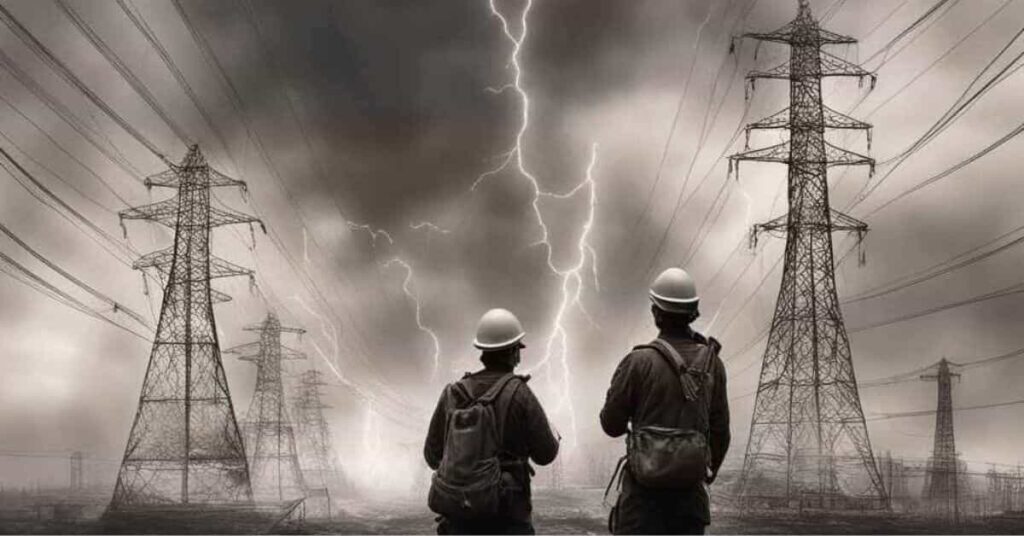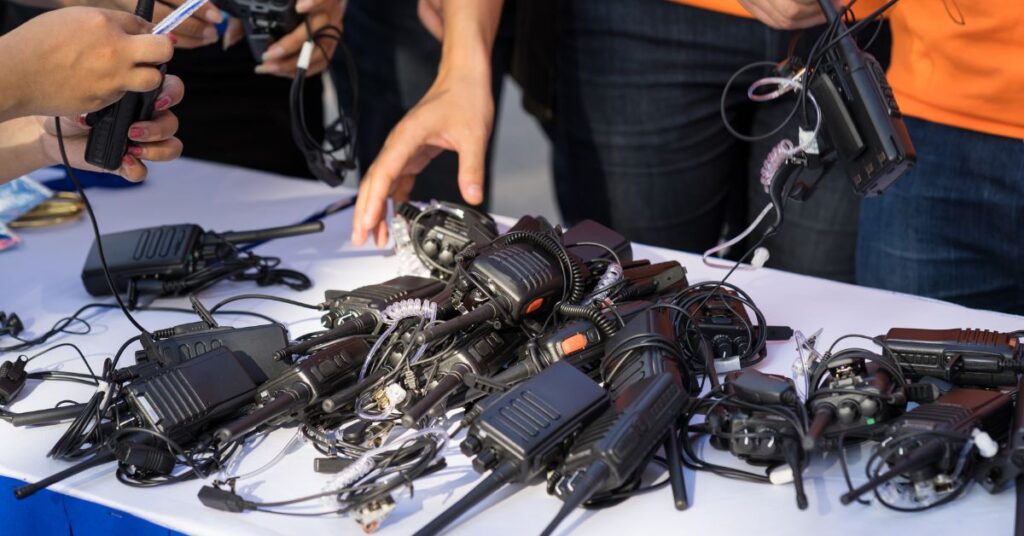
Our world sometimes faces big problems called Electromagnetic Pulses, or EMPs. They mess up electronic stuff like phones and computers. EMPs happen because of big storms or explosions. During emergencies, talking to each other is super important. We’re wondering if Walkie-Talkies will work after EMP. By learning how EMPs affect walkie-talkies, we want to help everyone prepare for emergencies. Knowing about EMPs and using walkie-talkies smartly can help us prepare for tough times. This blog post helps us understand EMPs better and gives tips on how to keep talking, even when things are tough. Let’s learn together and be ready for anything.
Contents
Understanding EMPs
What Causes an EMP?
An Electromagnetic Pulse (EMP) can happen because of natural and human-made things. Natural causes include big bursts of energy from the sun called solar flares or coronal mass ejections. These bursts travel through space and interact with Earth’s magnetic field, making EMPs. Human-made EMPs often come from high-up explosions of nuclear bombs or regular explosives. These events change the electromagnetic field quickly, making EMPs.
Effects after EMP on Electronic Devices
EMPs can mess up electronic devices and things like power lines and phones. When an EMP happens, it sends out a big wave of energy that can overload and break electronic circuits in devices. This can make devices not work right or stop working completely. It can cause problems in communication devices, power grids, and transportation systems. How bad the damage is depends on how strong the EMP is, how far away it is, and how strong the devices are.
Potential Scenarios Leading to EMP Events
EMP events can happen because of different situations, both natural and made by people. Natural EMPs, like ones from solar flares, don’t happen often, but they can mess up many electronic things on Earth. Human-made EMPs, especially from high-up nuclear explosions, are a big threat to society. People might do this on purpose in a war, or it could happen by accident with nuclear bombs. Knowing the situations that can cause EMPs is important so we can plan to stay safe and protect our things.
Impact of an EMP on Walkie-Talkies

Vulnerability of Walkie-Talkies to EMPs
Walkie Talkies can be damaged by Electromagnetic Pulses (EMPs) because they use electronic circuits to work. When an EMP happens, it sends out a big wave of energy that can overload and break these circuits, making the walkie-talkies stop working. Since walkie-talkies are small and don’t have much protection, they’re easily affected by EMPs.
Walkie-Talkie Models and Their Resilience to EMPs
Different types of walkie-talkies can handle EMPs differently based on how they’re made. Some walkie-talkies have special protection like shielding and surge suppression to help them survive EMPs. But most regular walkie-talkies that people use aren’t made to withstand EMPs. How well they handle EMPs depends on how they’re built and what materials they use.
Case Studies or Examples of EMP Effects on Walkie-Talkies
There have been times when EMPs have broken walkie-talkies. Many walkie-talkies and other communication devices stopped working correctly during military tests where they pretended to have EMPs. Also, in real-life situations like the Starfish Prime nuclear test in 1962, EMPs damaged communication systems, including walkie-talkies.
Protecting Walkie-Talkies from EMPs
Shielding Techniques to Protect Walkie-Talkies from EMPs
Shielding techniques help keep walkie-talkies safe from harmful Electromagnetic Pulses (EMPs). One way to shield them is by wrapping them in materials that stop electromagnetic radiation. This shielding stops EMPs from hurting the electronic parts inside the walkie-talkies. Also, keeping walkie-talkies in metal containers or shielded cases adds extra protection against EMPs.
Understanding Which Walkie-Talkie Models Are More Likely to Survive an EMP
Knowing which walkie-talkie models can handle EMPs better is important for being ready. Some models have special shields or features that make them tougher against EMPs. Looking into and choosing walkie-talkies, known for being strong and resistant to EMPs, can help during EMP situations.
Steps to Safeguard Walkie-Talkies from EMP Damage:
- Keep walkie-talkies in shielded containers or cases when not in use to protect them from EMPs.
- Regularly inspect walkie-talkies for any signs of damage or wear to identify potential vulnerabilities.
- Store backup walkie-talkies in different locations to ensure communication capabilities during EMP-related failures.
- Educate users on proper handling and storage practices to minimize the risk of EMP damage to walkie-talkies.
Mitigation Strategies for Walkie Talkies
Alternative Power Sources for Walkie-Talkies
Walkie-talkies can use different power sources to keep working during emergencies, like when there’s an EMP. Options include rechargeable batteries, solar chargers, or hand-cranked generators. These backups provide power even if regular sources fail. With alternative power, walkie-talkies can keep communication going even without electricity.
Maintenance and Storage Tips for Walkie-Talkies in Preparation for EMP Events
Taking care of walkie-talkies is important to keep them safe from EMP damage. Check them often for damage, clean them from dust and dirt, and store them in protected containers when not used. Following a maintenance schedule and manufacturer’s instructions for storage can help walkie-talkies last longer and be stronger against EMPs.
Developing Redundancy Plans for Communication Systems
Redundancy plans mean having backup communication methods during emergencies, like EMP events. This might mean having extra sets of walkie-talkies in different places, using different communication tools like satellite phones or amateur radios, and having other ways to talk if the main ones don’t work. With backup plans, groups, and people can keep talking even when things are tough, lessening the impact of EMP events on communication.
Other Communication Alternatives Post-EMP
Assessing Different Ways to Communicate
After EMP event, figuring out which ways to communicate still work is important. Some options include landline phones, walkie-talkies, or handwritten notes. To decide what works best, we need to consider whether it’s available, how far it can reach, and if it’s reliable after EMP. Understanding what each method can do helps us adjust to the new communication method.
Why Having Backup Plans is Important
Backup plans mean having other ways to talk to each other, especially after an EMP event. Having different ways to communicate, like using radios, the internet, or sending letters, helps us stay connected even if the main ways stop working. Backup plans ensure that important information can be shared, even if something like an EMP happens.
Using Community Networks for Communication
After an EMP, community networks help people share information and work together. These networks include neighborhood groups, community centers, and local radio stations. Making plans and getting to know each other in the community helps us be ready for emergencies. Using community networks allows us to find help and support when needed, making it easier to recover after an EMP event.
Conclusion
EMPs can happen naturally, like from big storms, or they can be caused by people, like from explosions. These pulses can mess up the electronic parts inside devices, making them not work anymore. Walkie-talkies, which use electronics to communicate, can be damaged by EMPs. But some types of walkie-talkies have special shields that can help protect them. To keep walkie-talkies safe from EMPs, it’s a good idea to store them in special containers, check them often, and have backup plans in case they stop working. Using different power sources and looking into other communication methods, like using phones or talking to neighbors, can also help us stay connected during emergencies.
